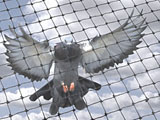
Preventing Bird-Borne Diseases
HOW do people get the avian flu? Avian influenza viruses circulate among birds worldwide. Susceptible birds can become infected with avian influenza virus when they have contact with contaminated nasal, respiratory, or fecal material from infected birds. They then shed the virus in their saliva, nasal secretions, and feces.
 HOW do people get the avian flu? Avian
influenza viruses circulate among
birds worldwide. Susceptible birds can
become infected with avian influenza virus
when they have contact with contaminated
nasal, respiratory, or fecal material from
infected birds. They then shed the virus in
their saliva, nasal secretions, and feces.1
HOW do people get the avian flu? Avian
influenza viruses circulate among
birds worldwide. Susceptible birds can
become infected with avian influenza virus
when they have contact with contaminated
nasal, respiratory, or fecal material from
infected birds. They then shed the virus in
their saliva, nasal secretions, and feces.1
Nearly all of the reported human cases
of the avian flu have involved contact with
infected birds: butchering or plucking
chickens, eating undercooked poultry, or
spending time in areas contaminated with
the blood or droppings of birds.2 Other
bird-borne diseases are ingested by
breathing airborne spores of bird feces.
Entomologist research has found more
than 60 transmittable diseases and dangerous
parasitic organisms that can be
fatal to some people and cause others to
fall ill. When dried-out droppings are disturbed,
a cloud of airborne dust carries
microorganisms into the lungs, causing
inhalation diseases such as histoplasmosis,
which is the most common of the diseases
associated with pest birds. Eating or
drinking foods that have come into contact
with bird-related bacteria can cause
ingestion diseases, such as toxoplasmosis
and query fever.3West Nile virus has been
detected in dead birds of at least 138
species. Although infected birds—particularly
crows and jays—can die or become
ill, most infected birds do survive.4
What can someone do to stay safe?
Because we can’t easily know which birds
or animals are infected with disease, care
should be taken when in a potentially
risky situation. Use gloves when picking
up dead birds or mammals, or grab the
carcass with a plastic bag and then invert
it to the inside of the bag. Contact your
county or state health department. If these
personnel want the dead bird or animal,
they will make arrangements to come get
it. If not, it’s best to double bag it in plastic
and put it in the trash.5
BIRD-BORNE DISEASES
|
¦ Avian Flu
¦ Fowl Typhoid
¦ Infectious Coryza
¦ Paratyphoid
¦ Salmonellosis
¦ Streptococosis
¦ Tuberculosis
¦ Aspertillosis
¦ Blastomycosis
¦ Cryptococcosis
¦ Histoplasmosis
¦ Trypansomiasis
¦ Toxoplasmosis |
¦ Trichomoniasis
¦ Chlamydiosis
¦ QFever
¦ Encephalitis
¦ Meningitis
¦ Newcastle Disease
¦ Pox
¦ Taeniasis
¦ Dispharyxiasis
¦ Eyeworm
¦ Schistosomiasis
¦ Acariasis |
How can safety managers help? They
can protect employees from the dangers
associated with roosting birds. Whether
on ledges of manufacturing plants or
other work sites or in the rafters of warehouses
of all kinds, bird droppings are a
health hazard that can be alleviated by
using a variety of bird control devices.
When choosing among bird control systems,
follow these steps:
¦ Analyze the problem. Identify the type
and number of birds causing the problem.
Note the areas where they are landing and
roosting. Eliminate food and water
sources if possible. This may be accomplished
by keeping buildings and grounds
free of trash. Make sure all garbage receptacles
and dumpsters are kept closed.
Ground puddles, standing water on roofs,
and clogged gutters are areas that will
attract birds, and they are relatively easy
to eliminate. Other water sources, such as
fountains and ponds, may be difficult to
take away and may need to be protected
with bird netting. Many buildings and
structures located near city parks have
bird problems; it can be helpful to contact
your city and propose a no-feeding ordinance
to help reduce the number of birds
in the area.
¦ Research available products. Choose a
reliable company that offers free technical
support and installation plans. Don’t
make your decision on price alone. Consider
maintenance costs, product lifespan,
and installation costs when comparing
price and value.
¦ Consider using a combination of products
if necessary. The products you choose
depend on the size and number of birds,
the types of areas you wish to protect, and
a host of other factors. “Porcupine wire”
and bird netting are effective, durable, and
economical, providing they are of quality
construction and installed properly. Pin
and wire, non-lethal chemical repellents,
and scare devices have their place in some
situations. Sticky pastes and ultrasonic devices are not recommended.
¦ Plan the installation properly. Decide
whether you want to install the bird control
products yourself or have a qualified
contractor do the job. Either way, make
sure that all areas have been carefully
measured per manufacturers’ instructions
to ensure that you order the correct
amount of materials.
¦ Treat droppings with caution. Protective
clothing, gloves, and respiratory masks
should be used when working around bird
droppings. Thoroughly cleaning, disinfecting,
and deodorizing the surface is
imperative in order to protect people from
infection. It also discourages pest birds
from following the scent back to their old
roosts. When dealing with large quantities
of bird guano, it is recommended to check
with your local health department for
proper disposal methods.
Product Alternatives
Porcupine wire
When used properly, porcupine wire is
one of the most effective, versatile, and
long-lasting forms of bird control available.
There are many applications for this
type of repellent: building ledges, parapets,
roof ridges, gutters, signs, awnings,
air conditioners, rafters, shutters, and
almost anywhere a bird can land. Be
careful when choosing a porcupine wire
product. Some of the deterrents are constructed
of all high-quality stainless steel,
some are made of plastic, and others use a
combination of the two. The stainless
steel models cost a bit more, but the
longevity they provide is worth it. Plastic
can become brittle when cold and soft
when hot and will eventually deteriorate
from direct exposure to sunlight.
Look for a deterrent that will repel
birds of all shapes and sizes. Many of the
porcupine wire products available have
large gaps between the wires, and small
birds may be able to sit or nest in between
them. To avoid this situation, it is very
important to choose a product that has
120 points per foot, strategically configured
close together and pointing in all
directions. It is critical to protect the
entire surface area. Don’t hesitate to call
your supplier for planning assistance.
Bird netting
If you have an open warehouse, building,
or overhang where birds are getting up
into the rafters and beams, bird netting is
an effective and economical choice. When
choosing netting, it should be strong and
lightweight, with openings 3/4 inch
square or smaller. Larger openings may
not prevent smaller birds such as sparrows
from getting through. Make sure the netting
is a dark color and ultravioletstabilized
to reduce deterioration from
exposure to the elements.
Safe chemical bird repellents
One manufacturer offers safe chemical bird
repellents under the names MigrateTM and
Fog ForceTM. These are formulated from a
food grade ingredient, methyl anthranilate,
a naturally occurring compound with
reduced risk to the environment. Migrate
and Fog Force are regulated by EPA under
FIFRA (the Federal Insecticide, Fungicide,
and Rodenticide Act).
Fog Force™ Bird Repellent is a fogging
agent that is an efficient tool for the
management of nuisance birds without
harming target and non-target birds or
other animals. As a proactive method, it does not depend on birds to taste the
repellent by eating treated food.
Thermal or mechanical fogging of Fog
Force™ relies on the exposure of the
birds to the fog. After several exposures
to the fog, the birds generally leave the
area completely and do not return for the
season. Automated fogging systems
inhibit any future re-infestation from
new bird populations and ensure a birdfree
environment.
Migrate™ for Turf is a tool for the
behavior modification of Canada geese
(Branta Candensis). As a taste aversion
agent, Rejex-it® Migrate™ changes the
taste of the grass to make it unpalatable to
geese. This causes the geese to leave the
area completely to find better feeding and
living conditions.
Sticky paste and liquid repellents
The author does not recommend these
products for a long-term solution. Over
time, the compound will discolor and
attract dirt, bugs, and debris, which will
drastically reduce the product’s effectiveness.
When this happens, the compound
will have to be cleaned up and reapplied.
Post & wire bird deterrent
This type of system can be very laborintensive.
Post and wire barriers generally
blend in well but should be used only for
repelling large birds in very light pressure
areas. In heavy infestation situations, birds
can roost and build nests into the wires.
These systems work best when covering
very narrow surfaces such as railings,
along balconies, and where there is moderate
human activity.
Some companies have modified the
wire systems to transmit a low-voltage
current through the wires to help repel
the birds. This type of system is more
effective but very expensive to install and
requires considerable maintenance. If not
installed properly, the electric wires may
present a fire hazard.
Ultrasonic devices
Ultrasonic devices are not recommended
for effective bird control. If you are considering
using this type of system, do some
research and get legitimate references.
Scare away devices
Owl statues, balloons, and reflective strips
used to scare away birds may work for
only a few days or maybe a week, if you
are lucky. The scare balloons seem to
work better than the owls because they
move around with the wind. You may find
it helpful to change the balloon position
and color frequently to help prevent the
birds’ getting used to them.
References
1. www.audubon.org/bird/avianflu/
avianflu.htm
2. Consumer Reports Medical Guide
.com, January 2006.
3. National Pest Control Association
Inc., 1982 Bird Management Manual
4. Centers for Disease Control Web site
5. National Audubon Society, 2005
“West Nile Virus,” www.audubon.org/
bird/wnv/
Helpful Links
www.cdc.gov/flu/avian/gen-info/facts.htm
www.nixalite.com
www.grain.org/briefings/?id=194
www.fws.gov/migratorybirds/issues/Avian
Flu/WBAvianFlu.htm
This article originally appeared in the June 2007 issue of Occupational Health & Safety.